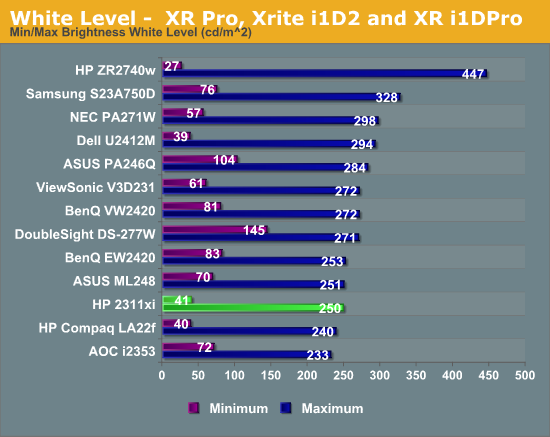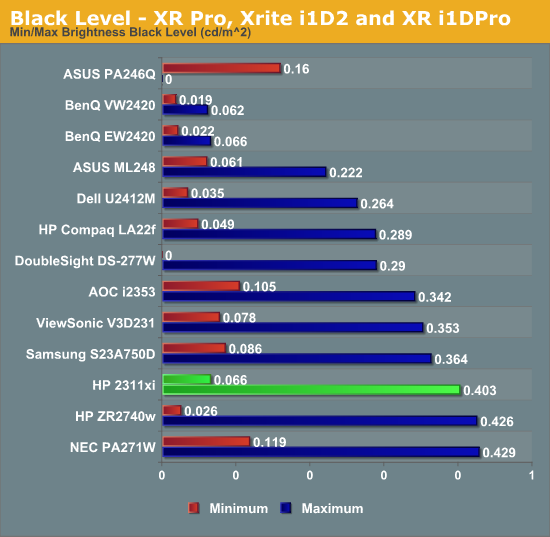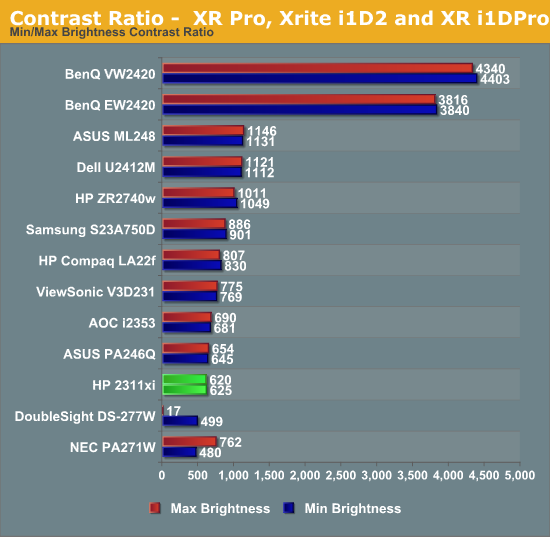HP 2311xi IPS Monitor
by Chris Heinonen on August 13, 2012 12:15 AM ESTHP 2311xi - Brightness and Contrast Ratios
HP rates the 2311xi for 250 nits maximum brightness and that’s exactly what I found it produced. If I turned the brightness all the way down it then put out only 41 nits, which gives you a lot of flexibility around adjusting the backlight level. 250 nits should be enough light output for most people, but if you have direct sunlight on your display for most of the day you might need something even more powerful to avoid it looking washed out.

For measuring the black levels, I made sure to leave the Dynamic Control off for the LEDs. With that enabled, it could potentially turn off the backlight completely, which would result in a black level of 0.000, but one that has no practical implications aside from a totally black screen. By leaving that disabled, we get a real-world measure of the black level. At maximum brightness, our black level is right around 0.4 nits, which is a little higher than other displays we have measured with similar peak white levels. The minimum level was 0.066, which correlates well with the white level change. Black levels are typically a little worse with IPS than with VA panels, which is the trade off for getting the other advantages an IPS display offers for color and viewing angles.

Looking at the contrast ratio, we are almost exact the same at minimum and maximum backlight, right around 620. I went ahead and measured this at 0-100% in increments of 10, and every measurement was between 620 and 625, so it’s a very consistent contrast ratio all across the range. It’s a perfectly normal and average contrast ratio, about what I’d expect from a budget IPS display.

Looking at the Brightness and Contrast numbers, the HP 2311xi is a decent but not exceptional performer. Nothing stands out, but everything about the performance so far is perfectly acceptable with the price involved.










68 Comments
View All Comments
Khenglish - Monday, August 13, 2012 - link
When I saw that a 23" version of a 27" screen was being released, I was hoping that it would be the same 2560x1440 resolution. Sadly it was not.Why can't anyone make a monitor with a pixel density higher than my 2002 CRT? A 19" 2560x1600 screen would be awesome and I would pay a lot for it. I'd rather not have to turn my head to look from one corner to the other with a 27" or 30" screen.
tecknurd - Monday, August 13, 2012 - link
Manufacturing a CRT to display high resolutions like 2560 by 1600 does not require much. The electronics are what is require to handle resolutions. LCD on other hand, silicon cost a lot to make that amount of pixels and the high performance panel driver is then needed, so LCD has two pricey hardware to make a finish product. CRT just need the electronics.Using a 27 inch or 30 inch screen, you just need to sit further from it to see it all at once.
Sabresiberian - Monday, August 13, 2012 - link
Really, the problem of price isn't as much of a barrier as we've been lead to think, as the influx of $300 (including shipping for S. Korea) 2560x1440 monitors has shown. Also, there are inexpensive phones and tablets that have far higher pixel densities than the monitors currently available.As far as using a bigger screen and sitting farther back - wut? That's, uh, not very practical and really makes no sense.
;)
Zoomer - Tuesday, August 14, 2012 - link
These korean monitors get lower grade panels. In other words, panels that are rejected for inclusion in top brands like Apple, HP, Dell, etc. That's why they are priced at that point.Phones and tablets use must smaller screens, and therefore, exponentially easier to make without defects.
scarhead - Monday, August 13, 2012 - link
They will come before long. There's already a 15" laptop with 2880 x 1800.janderk - Monday, August 13, 2012 - link
High res displays have been here for a long time. Problem is price.For the price of that Apple laptop you mentioned, you can buy 15 HP IPS monitors. What is a shame is that all other Apple laptops feature low quality TN displays.
It is quite revolutionary that you can buy a good IPS display for $200. One with 1200 vertical pixels even. I remember paying 1600 Euro for my 23" HP 2335 IPS display some years ago.
janderk - Monday, August 13, 2012 - link
Correction to myself: The display is 1080. Not 1200.KZ0 - Monday, August 13, 2012 - link
Macbook Pro Retina uses an IPS panel.http://www.anandtech.com/show/5998/macbook-pro-ret...
janderk - Monday, August 13, 2012 - link
That's why I said "all other".Tetracycloide - Monday, August 13, 2012 - link
I believe that's the one scarhead was referring to and the one janderk was excluding when he said 'all OTHER Apple laptops.'